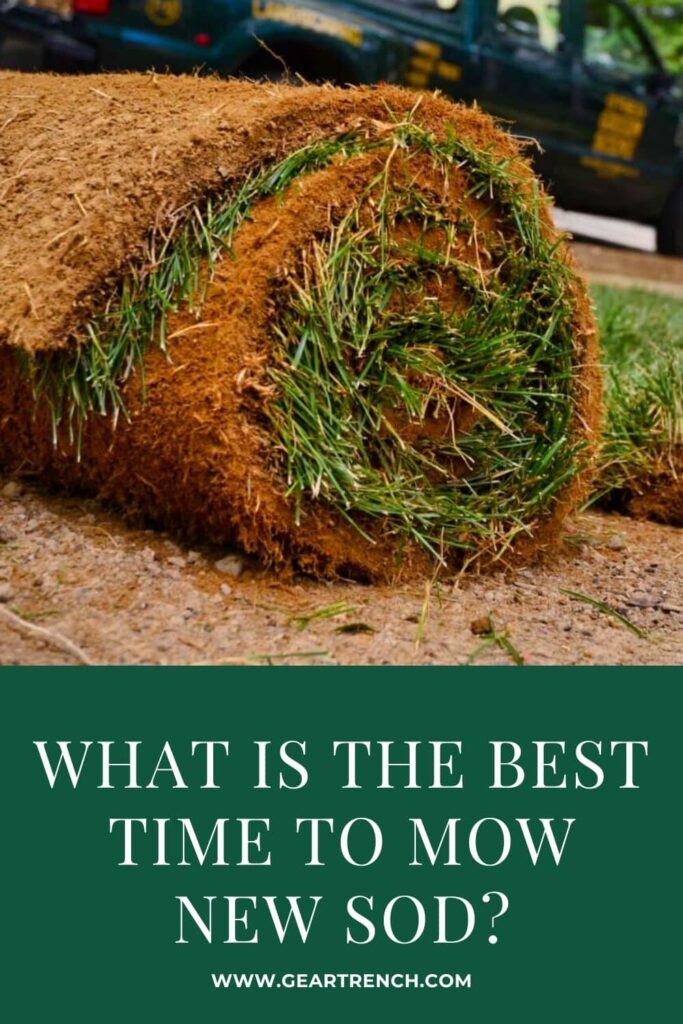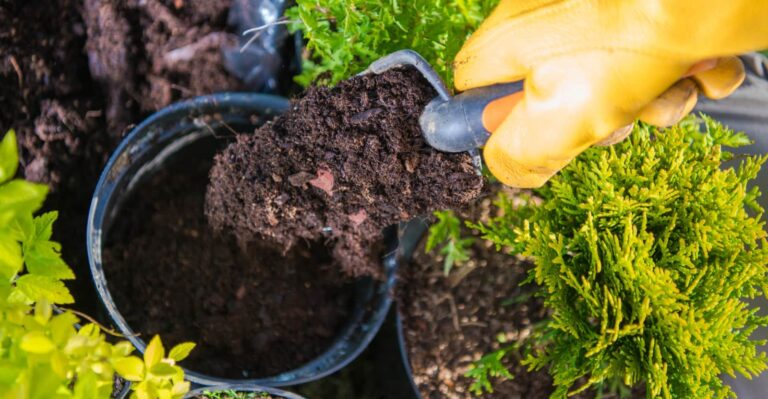Amazon has put together some great Home Gift Deals – save money and get your shopping done at the comfort of your home! Click here to see deals on Amazon
It’s natural to feel excited when you see your newly installed sod and want to give it the best care possible. A healthy green lawn improves the appearance of your home and offers sufficient lawn greenery around the house.
You need to take proper care of newly installed sod for its future health and appearance. I often get asked by people when to mow new sod, so I decided to do some reading and research, and here is what I found.
What is the best time to mow new sod?
When to mow new sod? You should wait at least 14 days after laying down sod on the ground. If you have installed new St. Augustine sod or Bermuda sod in summer, wait 10 to 14 days. If you have installed sod in winter, then you have to wait longer up to 21 days before the sod becomes ready for mowing.
You can check if the sod is ready to mow by gently pulling it at the corner. If the root has firmly established in the ground, you won’t be able to pull it out quickly. This indicates that it’s ready to be mowed.
Pay close attention to the sod separation areas. It usually takes a bit longer for sod roots to cross over to give a seamless appearance. Wait for a few more days and water it thoroughly if the root appears to be not adequately held to the ground.
Where to buy sod?
Most brick-and-mortar retailers such as Home Depot, Lowes, and local landscaping companies sell sod. If you’re getting sod installed by professionals, then many landscapers have their custom supply chain to source the sod.
The important thing is to know that you’re getting high-quality, healthy sod for your lawn. If you’re buying it on your own, check the quality by looking at some key attributes of sod, such as soil consistency, mature grass, and root conditions.
Inspect that the sod has a solid, consistent green color, and the soil is intact on delivery. A sod harvested when the grass is fully matured makes it easy to install and increases the chance of growing quickly.
How much does sod cost?
Several factors determine the sod cost. Most of the pricing depends on grass and grade quality. On average, the sod costs anywhere from $0.30 to $0.85 per square foot. If you’re buying in pallets, most mid-grade pallets cost anywhere from $260 to $380.
The price also varies based on the area you live in. Expect to pay a premium during the busy season as compared to when buying off-season like in fall.
If sod cost seems excessive, then you can always go through a much cheaper seeding route. It’s relatively less expensive but takes some time for the turf to grow. Once seeded, it takes up to two years for a seedling to mature and provide you with proper grass coverage.
What to do after sod is laid?
Once the sod is installed, you need to provide it with proper care for the healthy roots to grow. This starts by immediately watering the sod and preventing it from getting exposed to excessive heat.
Don’t walk on the newly laid sod for at least two weeks as the roots take some time to get to the ground. Wait till you have mowed it the first time after two weeks. Pay close attention to the sod edge as often it gets neglected, and the sod shrinks.
Ensure the corner gets enough water and press it with afoot to keep it attached to the ground. Consistent watering is needed to grow a more robust root. In summer days, water it twice during the morning and evening to prevent soil from getting dry.
Keep the sod well moisturized. It reduces the time it takes for the root to grow and support the turf.
How long does sod take to root?
Sod roots take anywhere from 10 to 14 days to get a firm grip on the ground. A proper watering schedule is essential to help develop the root. Don’t overwater the soil before sod installation as the soaked and muddy ground makes it difficult to install correctly.
Keeping your lawn moist and watering it for 10 to 15 minutes, two to three times a day should allow the roots to grow properly.
Watering new sod: how much to water new sod?
Sods need water to help it grow. Sods are perishable and should be immediately laid down on the lawn once you receive it. If you’re not ready to install it, keep it in the shade until you’re prepared to install it. Spray light water on it to keep the grass and soil moist.
A right amount of watering is necessary as overwatering may cause root rot, and underwatering may cause the root to remain weak. After installation, you should soak the ground well with water. There should be enough water in the sod to let it stay moisturized for the next 8 to 10 hours.
You can use a lawn roller on the newly installed sod to reduce the gap between the sod layer and ground. A root touching the ground makes it easy to go deeper into the field. On the first day of sod installation, water it 5 to 6 times during the day for 10 to 12 minutes.
Don’t overwater it as it reduces the roots’ ability to circulate air, and excessive moisture may cause root rot. The irrigation requirements also depend on the soil type: Use the following guideline regarding the watering and soil type.
| Soil Type | Water Frequency | Time |
|---|---|---|
| Clay | 4 times a day | 4 minute |
| Sandy | 5 times a day | 7 minute |
Avoid watering late in the evening as it creates the risk of developing root fungus. You can test yourself if the sod has enough water by checking if the water pools under the sod for more than 2 or 3 minutes.
Make sure you water at least three times per week on new sod and maintain ½” water in each zone. If you’re using a lawn sprinkler, then space it out even during irrigation.
It allows the lawn to absorb water properly. You have to ensure that the yard gets 1.5″ of water per week for around 1.5 to 2 years to keep grass remain healthy.
When to fertilize new sod?
You can start fertilizing new sod after the turf has been established in the ground. It may take around 6 to 8 weeks after sod installation. Just make sure that you followed the proper watering schedule and watered it well.
If you have installed sod close to winter, and the ground has frozen, wait till the ground thaws after winter. Ideally, you would have put fertilizer before you had installed the sod. It gives the sod a head start, and the fertilizer provides the required nutrients to sod to grow it fully.
You can use all-purpose fertilizer such as 15-15-15 or use bonemeal fertilizer to apply on new sod. After you have installed the sod, you can start with starter fertilizer and apply 3 lb per 1,000 square-foot area. Wait for 4 to 5 weeks for the sod to absorb nutrients then aerate the lawn.
The aeration helps with better air circulation to the grass and encourages growth. Wait then another 4 to 5 weeks and apply Milorganite Fertilizer at full strength.
You also need to protect grass from insects such as beetles and larvae to hold on the grass. You can apply a Grub worm killer in midsummer to remove these insects taking hold of the lawn.
Wait for another 7 to 8 weeks and apply the starter fertilizer again, followed by aeration. If you find any weed, remove it from the grass so it won’t take up essential nutrients meant for the grass.
Should you leave grass clippings on new sod?
If you’re wondering whether you should leave grass clippings on new sod? The answer is, “yes.” The grass clippings, when left on a lawn, turn into a natural fertilizer.
This reduces the effort needed to clean up the clippings while also benefitting your lawn. After mowing, check the yard, and if you see any thick patch of clippings, just spread it nicely, so it doesn’t look out of place.
When it comes to mowing new sod, you have to mow at 3″ or higher all year long. The longer gap you maintain for the lawn mowing, the better chance the grass gets to catch more sunlight and grow healthier.
You should only mow new sod once you have ensured that the roots have held firm in the ground. You can test it by gently pulling and seeing how it holds.
Adjust your mowing height and ensure that the mower has sharp blades for a clean cut. If mowing in the chilly weather, you can lower the mowing height to 1.5″ to 2″ as it encourages growth.
You should mow your lawn diagonally and wait for a day or two after you had watered the garden. Make sure the ground is firm and dry enough for it to hold the mower weight. I use the zero turn mower and you can know more about the best zero turn mower in our detailed review.
Many people mistakenly believe that grass clipping results in thatch buildup, but that isn’t true. Thatch consists of grassroots and stems, whereas the clippings are the top layer of grass that biodegrades and provides nutrients to your existing turf.
In conclusion: When to mow the new lawn
For a healthy and good-looking lawn, proper mowing is vital. You should wait till the grassroots has taken an adequate grip in the soil and mow it after two weeks of sod installation. Water it consistently and timely to keep grass growing healthy.
Image credit: slgkckgc

Don’t forget to share this post







